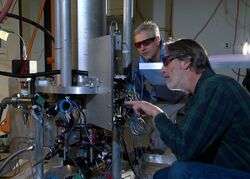Physics:NIST-F2
NIST-F2 is a caesium fountain atomic clock that, along with NIST-F1, serves as the United States ' primary time and frequency standard.[1] NIST-F2 was brought online on 3 April 2014.[1][2]
Accuracy
File:The NIST-F2 Atomic Clock, How does it work?.webm NIST-F1, a cesium fountain atomic clock used since 1999, has a fractional inaccuracy (δf / f) of less than 5×10−16.
The planned performance of NIST-F2 is δf / f < 1×10−16.[3] At this planned performance level the NIST-F2 clock will not lose a second in at least 300 million years.[4]
Evaluated accuracy
The evaluated accuracy (uB) reports of various primary frequency and time standards are published online by the International Bureau of Weights and Measures (BIPM). The first in-house accuracy evaluation of NIST-F2 reported a uB of 1.1 × 10−16.[5] In March 2014 and March 2015 the NIST-F2 cesium fountain clock reported a uB of 1.5 × 10−16 in the BIPM reports of evaluation of primary frequency standards.
The last submission of NIST-F1 to BIPM TAI was February 2016.[6]
At the request of the Italian standards organization, NIST manufactured many duplicate components for a second version of NIST-F2, known as IT-CsF2 to be operated by the Istituto Nazionale di Ricerca Metrologica (INRiM), NIST's counterpart in Turin, Italy.[1] As of February 2016 the IT-CsF2 cesium fountain clock started reporting a uB of 1.7 × 10−16 in the BIPM reports of evaluation of primary frequency standards.[7][8]
References
- ↑ 1.0 1.1 1.2 NIST Launches a New U.S. Time Standard: NIST-F2 Atomic Clock
- ↑ First Accuracy Evaluation of NIST-F2, T. P. Heavner, S. R. Jefferts, J. H. Shirley, T. E. Parker, E. A. Donley, N. Ashby, S. Barlow, F. Levi, and G. Costanzo, May 2014
- ↑ Jefferts, Steven R.; Heavner, Thomas P.; Parker, Thomas E.; Shirley, Jon H. (September 2007). "NIST Cesium Fountains — Current Status and Future Prospects". International School and Conference on Optics and Optical Materials, ISCOM07. 112. Belgrade, Serbia. 759–767. doi:10.1117/12.734965. http://przyrbwn.icm.edu.pl/APP/PDF/112/a112z506.pdf. Also available from NIST directly.
- ↑ "Time gets an upgrade". New Scientist: p. 7. 12 April 2014. https://www.newscientist.com/article/mg22229642-700-60-seconds/.
- ↑ Heavner T P, Donley E A , Levi F, Costanzo G, Parker TE, Shirley J H, Ashby N, Barlow S and Jefferts SR, “First accuracy evaluation of NIST-F2,” 2014 Metrologia 51, 174–182, May 2014
- ↑ "BIPM - Time Department FTP server". https://www.bipm.org/en/bipm-services/timescales/time-ftp/Circular-T.html#nohref.
- ↑ February 2016 IT-CsF2 TAI evaluation
- ↑ June 2018 IT-CsF2 TAI evaluation
External links
- NIST Time and Frequency Div. — 2004: Strategic Focus 1 (National Institute of Standards and Technology)
- "Time gets an upgrade" (in English). New Scientist. https://www.newscientist.com/article/mg22229642-700-60-seconds/. Retrieved 27 February 2018.
 |


